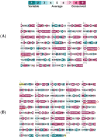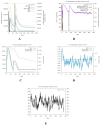Mining Autoimmune-Disorder-Linked Molecular-Mimicry Candidates in Clostridioides difficile and Prospects of Mimic-Based Vaccine Design: An In Silico Approach
- PMID: 37764144
- PMCID: PMC10536613
- DOI: 10.3390/microorganisms11092300
Mining Autoimmune-Disorder-Linked Molecular-Mimicry Candidates in Clostridioides difficile and Prospects of Mimic-Based Vaccine Design: An In Silico Approach
Abstract
Molecular mimicry, a phenomenon in which microbial or environmental antigens resemble host antigens, has been proposed as a potential trigger for autoimmune responses. In this study, we employed a bioinformatics approach to investigate the role of molecular mimicry in Clostridioides difficile-caused infections and the induction of autoimmune disorders due to this phenomenon. Comparing proteomes of host and pathogen, we identified 23 proteins that exhibited significant sequence homology and were linked to autoimmune disorders. The disorders included rheumatoid arthritis, psoriasis, Alzheimer's disease, etc., while infections included viral and bacterial infections like HIV, HCV, and tuberculosis. The structure of the homologous proteins was superposed, and RMSD was calculated to find the maximum deviation, while accounting for rigid and flexible regions. Two sequence mimics (antigenic, non-allergenic, and immunogenic) of ≥10 amino acids from these proteins were used to design a vaccine construct to explore the possibility of eliciting an immune response. Docking analysis of the top vaccine construct C2 showed favorable interactions with HLA and TLR-4 receptor, indicating potential efficacy. The B-cell and T-helper cell activity was also simulated, showing promising results for effective immunization against C. difficile infections. This study highlights the potential of C. difficile to trigger autoimmunity through molecular mimicry and vaccine design based on sequence mimics that trigger a defensive response.
Keywords: Clostridioides difficile; autoimmunity; bioinformatics; docking; immune response; molecular mimicry; pathogenesis; vaccine design.
Conflict of interest statement
The authors declare that they have no conflict of interest.
Figures





Similar articles
-
Molecular Mimicry Mapping in Streptococcus pneumoniae: Cues for Autoimmune Disorders and Implications for Immune Defense Activation.Pathogens. 2023 Jun 21;12(7):857. doi: 10.3390/pathogens12070857. Pathogens. 2023. PMID: 37513704 Free PMC article.
-
Potential T cell epitopes of Mycobacterium tuberculosis that can instigate molecular mimicry against host: implications in autoimmune pathogenesis.BMC Immunol. 2012 Mar 21;13:13. doi: 10.1186/1471-2172-13-13. BMC Immunol. 2012. PMID: 22435930 Free PMC article.
-
Subtractive genomic approach toward introduction of novel immunogenic targets against Clostridioides difficile: Thinking out of the box.Microb Pathog. 2022 Jan;162:105372. doi: 10.1016/j.micpath.2021.105372. Epub 2021 Dec 22. Microb Pathog. 2022. PMID: 34954046
-
Molecular mimicry and autoimmune thyroid disease.Rev Endocr Metab Disord. 2016 Dec;17(4):485-498. doi: 10.1007/s11154-016-9363-2. Rev Endocr Metab Disord. 2016. PMID: 27307072 Review.
-
Chlamydia and antigenic mimicry.Curr Top Microbiol Immunol. 2005;296:153-63. doi: 10.1007/3-540-30791-5_9. Curr Top Microbiol Immunol. 2005. PMID: 16323424 Review.
Cited by
-
Current treatment of Psoriasis triggered by Cytokine Storm and future immunomodulation strategies.J Mol Med (Berl). 2024 Oct;102(10):1187-1198. doi: 10.1007/s00109-024-02481-1. Epub 2024 Aug 30. J Mol Med (Berl). 2024. PMID: 39212718 Review.
References
-
- Topi S., Bottalico L., Charitos I.A., Colella M., Di Domenico M., Palmirotta R., Santacroce L.J. Biomolecular Mechanisms of Autoimmune Diseases and Their Relationship with the Resident Microbiota: Friend or Foe? Pathophysiology. 2022;29:507–536. doi: 10.3390/pathophysiology29030041. - DOI - PMC - PubMed
-
- Guarneri F. Role of Microorganisms in Pathogenesis and Management of Autoimmune Diseases: Volume I: Liver, Skin, Thyroid, Rheumatic & Myopathic Diseases. Springer; Berlin/Heidelberg, Germany: 2022. The Concept of Infection-Triggered Autoimmunity; pp. 3–19.
Grants and funding
LinkOut - more resources
Full Text Sources
Research Materials
Miscellaneous

